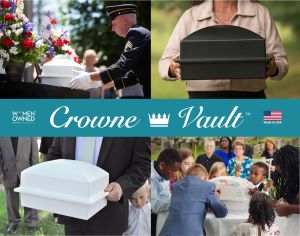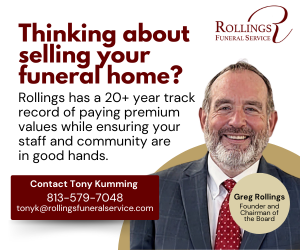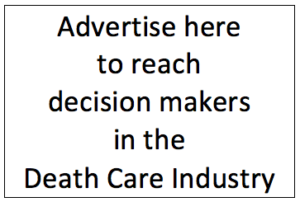Funeral Homes: Evolution thins the Herd

Businesses commission research studies when there are unexplained difficulties with the business; primarily “business is down and we don’t know why”. Over four decades funeral businesses commissioned hundreds of studies to explain the causes of declining business. During the 1980’s and 90’s many funeral businesses in New York city metro area experienced declining volume as retirees began leaving the city following retirement. The migration wasn’t immediately obvious, which caused operators to begin questioning their business. Over time, many funeral businesses closed or sold for property value; they transferred pre-needs, family files, phone numbers and business names to larger, remaining firms.
Facilities, pricing and staff members also caused declining at-need volume. However, the most common cause of decline was insufficient advertising. Research respondents indicated “reputation”, “not familiar with the firm”, or “know nothing about this business” as reasons not to select a funeral home. In other words, insufficient communication with the public.
Today’s article for Funeral Director Daily is authored by Glenn Gould. For 35 years, Glenn Gould was CEO of MKJ Marketing, a death care industry marketing firm serving funeral homes, cemeteries and death care industry vendors in areas of Digital Marketing, Market Research, Advertising and Training Programs. MKJ was founded in 1982 and had over 3000 funeral home clients throughout the US and Canada. In 2021 MKJ was acquired by Tribute Technology, a Carlyle technology roll-up; Glenn has continued with TT as a marketing consultant.
There were reported 22,000 funeral homes in the 1960’s and 70’s: most conducting fewer than 150 cases annually. Most firms served a specific neighborhood, church, religious or ethnic group. As such advertising other than sponsorships, church bulletin and public relations all that was necessary to maintain an on-going business.

Glenn Gould
As cremation became more popular through the 1980’s and 90’s, funeral businesses needed to serve larger geographic and demographic areas which was accomplished with elevated advertising and marketing. Those that refused to accept the new reality experienced declining business.
Advertising during that period was primarily in print, IE: newspaper, yellow pages, direct mail. Radio advertising never had much impact save “obituaries on the air” advertising in rural areas. Firms first to adapt to television advertising experienced accelerated growth, taking business from firms that failed to communicate. The cost of cable and broadcast advertising grew advertising budgets, but the results were impossible to measure, which made advertising a “leap of faith”.
The greatest competitive advantage of digital advertising is the ability to measure results. Results from pay-per clip (PPC), social media advertising, over-the-top television and geo-fencing enable the client to identify productive advertising. This has caused advertising budgets to grow even while marketing costs have declined as unproductive advertising is discontinued.
Digital advertising has eliminated the need for market research as consumers effectively communicate what they like and dislike about various competitive firms by the selections they make. Competitors can view each-others’ ads to identify more successful messages. So why do so few funeral homes effectively use digital marketing? Even more to the point, why do they continue investing in print advertising? After all, the fact that the daily newspaper is down to once or twice weekly indicates declining readership.
The combination of cremation and digital marketing also challenge the logic of branch facilities in the same market. The threat of being a primarily cremation business with too much overhead should cause owners to question the logic of acquisitions that add addresses but fail to create sufficient profits. Just as in the 1980’s through 2000’s, cremation is causing funeral facilities to sell for property values while selling pre-needs and family files to larger firms.
Many of the expenses borne by funeral businesses in the past are now superfluous which has created opportunities for investors to open mortuary service businesses. Providing first call, embalming, cremation, drivers and vehicles on an as needed basis reduces over-head costs while making more productive use of the declining number of licensed directors and embalmers.
Again, just as in the past, firms that fail to adapt to the changing environment will suffer losses, causing more firms to sell for property value and the continued growth of larger firms.
More about Glenn Gould:
As CEO of MKJ Marketing, Glenn assisted funeral homes and death care industry vendors in establishing marketing and advertising plans. He is recognized for his market research services having conducted over 800 positioning and prospective trade area studies throughout the US and Canada. In addition to quantitative research studies for funeral homes and cemeteries, Glenn moderated one-on-one interviews, focus groups and test panels.
In addition to MKJ Marketing, Glenn held executive positions with Bausch & Lomb, General Mills and the Batesville Casket Division of Hillenbrand Industries. He is a recognized speaker at industry conferences, seminars and conventions. His articles appear regularly in funeral service publications. His two books “Deathcare Marketing, 25 FAQ’s” and “Funeral Home Marketing-Moving The Bottom Line” have sold thousands of copies and are in use at mortuary colleges nationally.
Glenn has testified as an expert witness in multiple civil suits between funeral homes, served on the Board of Directors of the Pittsburgh Institute of Mortuary Science and instructed the Small Business Class for the St. Petersburg College, School of Mortuary Sciences. Glenn holds B.A. and M.S. degrees.

Tom Anderson
Funeral Director Daily
Funeral Director Daily take: On Monday Funeral Director Daily published an article that had to do with the number of funeral homes in the United States and the “Average Revenue per Firm”. That data confirmed that there were 15,703 funeral homes in the United States in 2022 — down from author Gould’s estimate of 22,000 back in the 1960’s.
That’s a 30% decrease over those years and some of the decrease would have to be associated with the lack of evolving into a funeral facility that profitably handled the increase in cremation disposition cases over the years.
It’s easy to see that funeral service is continuing to evolve and I believe that we will see another 30% reduction in the number of traditional facilities that operate Death Care services over the next 20-30 years. As Glenn Gould makes the point, make sure your funeral home evolves with the changing consumer habits so that you’re not one of those reductions.
More news from the world of Death Care:
- Hillenbrand explores strategic options including potential sale. Investing.com
- Why Sun Life partnered with Empathy to address the “unmet needs” in benefits. Business and Pensions Monitor
- Connecticut funeral home owner accused of theft puts three properties up for sale. Stamford ADvocate (CT)
- Cemetery at center of $6.7 million infrastructure dispute in Martindale. Lockhart Post-Register (TX)
Enter your e-mail below to join the 3,199 others who receive Funeral Director Daily articles daily
“A servant’s attitude guided by Christ leads to a significant life”





















